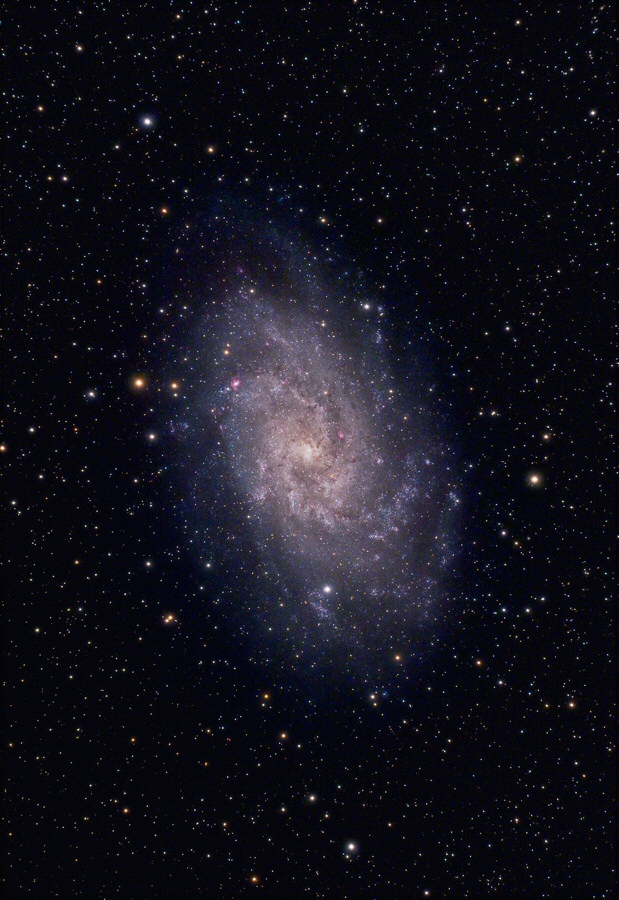
M33 is a nearby face-on spiral galaxy with large, "S"-shaped, open arms and a small central bulge, this galaxy type is called Sc(s). Astronomers call spiral arms of galaxies like this one "flocculent" because of their knotty, somewhat ill-defined structure, in contrast to "grand design" spirals. The Triangulum Galaxy is a member of our Local Group of galaxies, its distance being only 3.0 million light years, slightly further than the Great Andromeda Galaxy. It is in fact so near that bright stellar associations and active nebulous areas can easily be resolved.
Despite looking huge (the visible extent of this galaxy is 73 arcmins in large telescope photographs, more than four times the size of the full moon), M33 is a relatively small galaxy, its true diameter measures only about 50.000 light years, about half the diameter of our Milky Way galaxy. There are many globular and galactic star clusters in M33. The most prominent features are associations of blue giant stars, similar to our Orion or Perseus Associations. No supernovae have been observed in this galaxy, but a lot of supernova remnants have been detected in radio, optical and X-ray.
M33 was among the first galaxies identified as "spiral nebulae" by William Parsons, the Third Earl of Rosse. It was also one of the first "nebulae" identified as galaxies by Edwin Hubble in 1926.
 M33 - Triangulum Galaxy, Newtonian CCD-image and photograph.
M33 - Triangulum Galaxy, Newtonian CCD-image and photograph.
Exposure Data
Observing Hints
M33 is a difficult object for visual observation as it takes up a big area in the sky and has a low surface brightness, so a dark and transparent sky is needed for its observation, otherwise little can be seen. It is easy to be found, as it lies at about the same distance as M31 from the Andromeda chain of stars formed by Gamma, Beta and Delta, but at the opposite direction (towards the southeast). Under dark skies it is visible in almost any pair of binoculars, and even to the naked eye of sharp-eyed observers.
At low power in a small telescope the galaxy appears as big oval disk, with rising luminosity towards the center. It will take at least 6" of aperture and moderate power (40-50x) to distinguish the galaxy's spiral arms from the background. The two main spiral arms form an "S" shape. Larger telescopes will improve the view, with an 18" telescope at 100x four spiral arms are visible. There are a some HII regions visible within the galaxy; the brightest one is NGC 604 at the end of a bright spiral arm 10 arcminutes northeast of the galaxy's center and appears as fuzzy spot even in a 6"-telescope. There is a bright foreground star nearby. Further HII-regions in M33 are NGC 588, NGC 592 and NGC 595, hard-to-find objects for a 6" telescope but easier in bigger ones. If you have a big scope (about 18"), a trick might be used to identify the HII-regions: An OIII-filter will dim everything except the extragalactic emission nebulae, and there are more to be found than cataloged in sky charts like Uranometria. Especially NGC 604 should be quite spectacular in big telescopes at high power.